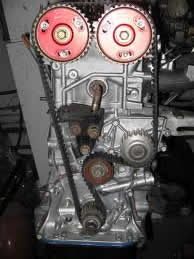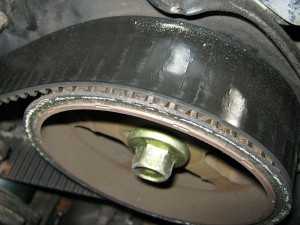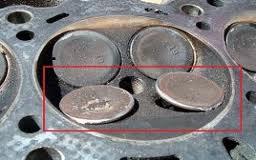The job of the timing belt is to keep the moving parts at the top of your engine in synchronization with the bottom moving parts. If these two halves of the engine come out of synchronization, the engine may sustain significant mechanical damage and possibly need replacement. Below (right) shows the the side of the engine. You can see (2) camshaft sprockets at the top of the engine and the crankshaft sprocket at the very bottom. If these three pulleys come out of synchronization with one another, the repair could be in the thousands.
The owner’s manual maintenance schedule is the source of timing belt replacement intervals, typically every 60,000 to 90,000 miles but there is always a time interval too, for example, 90,000 miles or 7 years. Its important to realize that the belt is made of rubber and because rubber is susceptible to dry rotting, the time interval is extremely important. That is to say that if your car is 10 years old but has low mileage, it is imperative that the timing belt be replaced. Below (left) is an example of a worn/cracking timing belt. This belt won’t hold on much longer.

When a timing belt breaks it can cause internal engine damage. Think “exploratory surgery” to find the damage a broken timing belt has caused. The picture below (right) shows what happens when a timing belt breaks from age or excessive mileage. To access the valve and piston the engine has to be partially disassembled which on some vehicles requires removal of the engine first. $$$ A broken belt will typically bend valves and in some cases even drive a valve through the piston. This illustration shows a bent valve which is internal to the engine.
Preventing Timing Belt Failure:
At Padonia Auto Service we highly stress preventitive maintenance over costly repairs. Our customers are always made aware of the intervals the factory recommends. If you are unsure of your timing belt replacement interval, call us at 410-666-3230. If a timing belt is changed as recommended there is no reason for any of the above to happen.
Timing Belt replacement at Padonia Auto Service:
When it comes to timing belt replacement, not all shops have the same procedure. As part of our timing belt replacement service, we also replace (2) other parts:
- Front oil seals – Every engine has a crankshaft and (1) or more camshafts. Each shaft has an oil seal around it. These seals are replaced during the timing belt procedure. The reason is because these seals are just as old as the timing belt and, they are also made of rubber. If any of these seals leak, not only will you have an oil leak, but you’ll have oil leaking on your brand new timing belt which will SIGNIFICANTLY reduce its life.
- Water pump – This is the part of your engine that circulates water/antifreeze to keep the engine cool.
The reason we replace these parts is purely preventative. They can leak or otherwise fail without any notice and it would be a shame to have not replaced them while they were exposed during a labor intensive job such as timing belt replacement. Considering the fact that during a timing belt job, replacement of these parts is the cost of the parts only, this is all but a must.
At Padonia Auto Service we are experts at timing belt replacement on Honda, Acura, Toyota, Lexus, Nissan, Infiniti, Mazda, Subaru, Mitsubishi, Scion, Isuzu, Kia, Hyundai, and Hybrid vehicles. If you have any further questions regarding this common auto repair procedure please stop by or schedule an appointment online today.
 We employ ASE Certified technicians, the industry standard for automotive repair certifications. Only the most committed technicians will test and become certified.
We employ ASE Certified technicians, the industry standard for automotive repair certifications. Only the most committed technicians will test and become certified.

